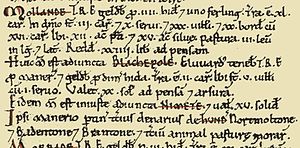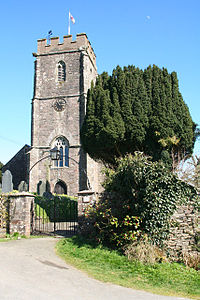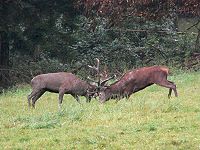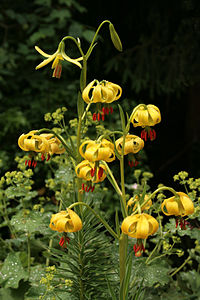- Molland
-
Molland is a civil parish and small village located on the southern slopes of Exmoor in North Devon, England. The former manor of Molland, largely co-terminous with the parish boundary, continues in existence as a large private estate under the ownership of Mrs Clare McLaren-Throckmorton(b.1935), [1] of Coughton Court, Alcester, Warwickshire, the niece and sole heiress of Sir Robert George Maxwell Throckmorton, 11th Baronet (1908-1989), whose family inherited the manor in 1732 from the family of Courtenay of Molland, a cadet branch of the House of Courtenay, Earls of Devon, which had inherited Molland in the 15th c. from the family of Botreaux. The estate comprises 6,250 acres, 1,700 of which are accounted for by Molland Moor, and includes 40 residential properties forming most of Molland village, 13 farms, the London Inn public house and additional land lettings.[2]
Contents
Church of St. Mary
 Church of St. Mary, Molland, looking eastward over box pews. On the tympanum above the chancel screen is affixed a large triptych of decorated wooden panels, the central one dated 1808 displaying the Royal Arms of King George III with a panel on either side listing the Ten Commandments[3]The arcade forming the southern boundary of the north aisle is in a precarious state, leaning into the north aisle, and is supported by oak butresses resting on the outside wall
Church of St. Mary, Molland, looking eastward over box pews. On the tympanum above the chancel screen is affixed a large triptych of decorated wooden panels, the central one dated 1808 displaying the Royal Arms of King George III with a panel on either side listing the Ten Commandments[3]The arcade forming the southern boundary of the north aisle is in a precarious state, leaning into the north aisle, and is supported by oak butresses resting on the outside wall
The church is dedicated to St Mary and is of the 15th century. The interior is Georgian: there is a three-decker pulpit, box pews and the roofs are ceiled. The chancel is divided from the nave by an 18th century screen and there are many monuments to the Courtenays of West Molland.[4] The font is Norman and the altar rails are ca. 1700.
West Molland was the house of the Courtenays; it is one mile west and though apparently Georgian has Tudor features incorporated at the back.[5] The sixth Throckmorton Baronet assumed the additional surname of Courtenay in 1792 on inheriting the Courtenay estates of Molland, through his mother. However, none of his successors have used this surname.
Courtenay monuments
The following mural monuments are contained within the church:
John Courtenay(d.1660)
 Mural monument to John Courtenay(d.1660). Above is an escutcheon displaying the arms of Courtenay of Molland impaling Wyndham
Mural monument to John Courtenay(d.1660). Above is an escutcheon displaying the arms of Courtenay of Molland impaling Wyndham
This monument is situated on the north wall of the north aisle. John Courtenay(d.1660) was the son of Charles Courtenay and Ann Coles.
To the memory of ye Right Worshipfull John Courtenay of West Molland, Esq'r (He married Margarite the daughter of Sir John Windham of Orchard Windham in the county of Somerset, Knight, by whom he had two sonnes and fouer daughters, viz John, James, Katherine, Elizabeth, Margarite & Grace) He departed this life the 26th day of February Anno Dom(ini) 1660. To the memory also of the Right Worshipfull John Courtenay Esq'r sonn of the above named John Courtenay. He departed this life the 24th day of April Anno Dom(ini) 1684. On a roundel under: To the memory of Margarite ye wife of ye above named John Courtenay & daughter of Sir John Windham of Orchard Windham by the Lady Johan his wife who was daughter of Sir Henry Portman of Orchard Portman in ye county of Somerset, Knight. Shee departed this life the first day of October 1684. His second son James died at his residence in Meshaw in 1683, in which parish church there exists a mural monument to his memory in the style of the Molland monuments. He was however buried in Molland Church in the grave of his first wife Susanna Sandford, whose slate tombstone can be seen in the floor of the north aisle. In this same grave is also buried James's second wife Elizabeth Lynn(d.1700), who married James as her second husband and who erected the Meshaw monument. She married thirdly Philip Shapland of Swimbridge, as her slate mural monument on the east wall of the north aisle of Molland Church attests.
Monument of James Courtenay(d.1683) at Meshaw
 The heraldic achievement of James Courtenay(d.1683), Meshaw Church. A triple impalement: centre: Or, 3 torteaux a label of 3 points azure each point charged with 3 roundels in pale, differenced by a crescent azure (Courtenay of Molland, differenced for a second son); Dexter: Azure, 3 bars wavy argent (Sandford); Sinister: Or, a demi-lion rampant gules[7] (Lynn). Crest: Out of a ducal coronet or, a plume of 7 ostrich feathers 4 and 3 argent (Courtenay)[8]
The heraldic achievement of James Courtenay(d.1683), Meshaw Church. A triple impalement: centre: Or, 3 torteaux a label of 3 points azure each point charged with 3 roundels in pale, differenced by a crescent azure (Courtenay of Molland, differenced for a second son); Dexter: Azure, 3 bars wavy argent (Sandford); Sinister: Or, a demi-lion rampant gules[7] (Lynn). Crest: Out of a ducal coronet or, a plume of 7 ostrich feathers 4 and 3 argent (Courtenay)[8]
In the church of Meshaw is a mural monument with the following wording: To the memory of James Courtnay (sic) Esq.r. 2d son of John Courtnay of Molland in this county, Esq.r. who died at Meshaw House the 27th of March 1683 & was buried among his ancestors in Molland Church in ye grave of his first wife Susanna ye daughter of Henry Sandford of Ninehead Flory in ye county of Somers.t, Esq.r. His 2d wife & relict (being also relict of Lewis Rosier of Swymbridge in this county, Gent.) was Elizabeth daughter of Will. Lynn Esq.r of Southwicke in Northha.ton.re who to ye lasting memory of her Lord did this too slender monument afford, for in her judgement she could scarce approve so mean an offering for so great a love. Were it as great and lasting too as she could wish ye me(m)ory of his love should be, this marble would out live eternity.
The gravestone of his first wife Susanna Sandford can be seen in the floor of the north aisle of Molland Church. She was the daughter of Henry Sandford(d.1644) of Nynehead Court, Somerset (whose gravestone exists in the chancel floor of Nynehead Church), by Mary Ashford, heiress of Burlescombe, Devon.[9] The originator of this monument at Meshaw was James Courtenay's second wife Elizabeth Lynn(d.1700), daughter of William Lynn of Southwick Hall, 11 miles SW of Peterborough, which family resided there between 1442 and 1840. Elizabeth had married James Courtenay as her second husband, having first married Lewis Rosier(d.1676) of Swimbridge, whose monument can be seen in St James's Church, Swimbridge.[10]After James's death she married thirdly Philip Shapcote of Knowstone. Very curiously Elizabeth was buried, according to her wishes, in the same tomb in Molland Church as her second husband James Courtenay, who had already been buried therein together with his first wife Susanna Sandford. This is made clear by her mural slate memorial tablet im Molland Church on the east wall of the north aisle which reads as follows: To ye memory of Mrs Shapcote ye wife of Philip Shapcote of Knowstone Esq. who was second wife & relict of James Courtenay Esq. and now lyes in (thistle?) interr(ed) in ye same grave with him according to his passionate desires & her pro(mise) to him in testimony of their mutual love. Obiit 12.o [11]Nov. 1700. On the slate are engraved the arms of Shapcote 3 dovecotes[12] impaling Lynn Gules, a demi-lion rampant or.[13] The crest over the escutcheon, which would normally be that of the husband, is here a demi-lion rampant, the crest of Lynn.
John Courtenay(d.1732)
 Monument to John Courtenay(d.1732). The cherub at dexter holds an escutcheon of the arms of Courtenay of Molland. The cherub to sinister displays the arms of Giffard of Weare Giffard,[14] Devon: Sable, 3 fusils in fesse erminois.[15] The escutcheon above is an unheraldic combination of the 2 arms
Monument to John Courtenay(d.1732). The cherub at dexter holds an escutcheon of the arms of Courtenay of Molland. The cherub to sinister displays the arms of Giffard of Weare Giffard,[14] Devon: Sable, 3 fusils in fesse erminois.[15] The escutcheon above is an unheraldic combination of the 2 arms
On the east wall to the north of the chancel is situated a mural monument to John Courtenay(d.1732) the last Courtenay lord of the manor and last in the male line of Courtenay of Molland, great-grandson of John Courtenay(d.1660). He was the son of John Courtenay(d.1724) (son of John Courtenay(d.1684) by Mary Stucley, daughter of John Stucley of Affeton Castle by Elizabeth Coode) by Amy Clifford(d.1693), a daughter of Thomas Clifford, 1st Baron Clifford(d.1673) of Chudleigh. He had no children, nor did five other of his siblings, but one of his sisters, Mary Courtenay(bapt.1/2/1687), married William Paston of Horton Court near Chipping Sodbury, Gloucestershire, and their daughter Anne Maria Paston married Sir George Throckmorton(1721-1767), son of Sir Robert Throckmorton, 4th baronet. Molland manor thus passed into the Throckmorton family.
Underneath lyes interr'd the body of the Honourable John Courtenay Esq. who departed this life on the eleventh day of December 1732 aged 44. This monument was erected at the appointment of the Honourable Margaret Courtenay, relict of the said John Courtenay Esq. daughter and sole heiress to John Giffard late of Brightley in this county, Esq. "As good, as great, but living amongst sinners was translated" Wisdom 4th chap'r.[16] Underneath and on the left hand of the abovesaid Jn. Courtenay Esq. are reposited the remains of Margaret (his late wife & widow) who departed this life August the 30th 1743.
Domesday Book
 One of 3 entries for Molland in the Domesday Book of 1086
One of 3 entries for Molland in the Domesday Book of 1086
 One of 3 entries for Molland in the Domesday Book of 1086
One of 3 entries for Molland in the Domesday Book of 1086
 One of 3 entries for Molland in the Domesday Book of 1086. This manor in North Molton hundred was held by Tetbald, son of Berner, and is unrelated to today's Molland village, estate and former manor
One of 3 entries for Molland in the Domesday Book of 1086. This manor in North Molton hundred was held by Tetbald, son of Berner, and is unrelated to today's Molland village, estate and former manor
The Domesday Book of 1086 records 3 entries for Molland, 2 in South Molton hundred and 1 in North Molton hundred. The latter does not relate to the manor and village of Molland, but to a separate manor about 7 miles to the NW, now memorialized byn the name of Higher Molland Farm and Molland Cross nearby it. This manor in North Molton hundred was held by Tetbald, son of Berner, who was the father-in-law of Odo. The 2 entries for Molland in South Molton hundred relate to a former ancient division of the present manor into 2 parts: One part listed under the demesne of the king, the other under the lands of Geoffrey de Montbray(d.1093), Bishop of Coutances, both in the county of "Devenesira" or "Devrescira". [17] These two divisions of Molland became known as "Molland Bottreaux" after the Botreaux family and "Molland Champeaux" now memorialized by Champson Farm, between Molland Church and West Molland Barton.
Flora & fauna
Red Deer
Molland is at the southernmost extent of the grazing range of the Exmoor Red Deer herds, and there is much valuable woodland cover which forms a semi-permanent residence for deer in the form of the several commercial conifer woodland stands within the parish. These deer are hunted a few times each year according to a regular schedule by the Devon and Somerset Staghounds, which traditional activity is believed to keep the bloodlines well-mixed and healthy due to the effect such hunts have of dispersing stags and hinds to join and breed with far-off herds on Exmoor to the north.
Molland Lilly
Lilium pyrenaicum, known in Molland as "The Molland Lilly"
Many of the remote hedgerows within the parish contain isolated clumps of Lilium pyrenaicum, which is not a native British plant, but one which is native to the Pyrenees Mountains and other mountainous regions at a similar latitude. The clumps appear well-established and were possibly introduced several centuries ago, but are in all cases only found on the tops of hedgerows and not in meadows or waste-land. This suggests deliberate planting by human hand. The plant is thought by some to have been introduced by members of a religious community said to have maintained a park within the parish, now memorialized by a private residence named "Abbot's Park". However to assign any religious symbolism to this yellow variety of lilly would be difficult to justify as the essential symbolic element of the Virgin Mary's White Lilly is its whiteness, denoting purity.[18] Due to the widespread locations of the plant within the parish, beyond the boundaries of such park and unlikely to have spread by natural dispersal of its heavy seeds, it would seem to have been planted at the direction of a person who possessed proprietorial rights over the entire former manor, which suggests direction by a lord of the manor, or possibly by his wife, who wished to beautify the manor. It is thus probable that the original bulb was brought back from the Pyrenees by a former lord of the manor.
Game bird shooting
The shoots of Molland and West Molland are deemed amongst the 25 best shoots in the world by Alex Brant, and are renowned especially for high birds, pheasants and partridge. [19] Of the whole 6,250 acres of the Molland Estate,[20] the West Molland shoot uses 2,000 acres. The shoots which are long-established have been let-out by the Molland Estate since 2005 [21] to Bettws Hall Shooting Estates, a commercial shoot operator based in Wales.[22] The shoot was leased to the shotgun manufacturer Holland & Holland from 1998 to 2005.[23]
Archives
Archive historical documents relating to Molland covering dates c. 1230-1880 are held by Warwickshire Archives ("Shakespeare Centre Library and Archive"), under ref DR5.[24] The collection was deposited in instalments by Sir Robert Throckmorton between 1936 and 1960 having been accepted by the Commissioners of Inland Revenue in lieu of inheritance tax in 1997.
See also
Bishops Nympton and Molland railway station
Further reading
- Pole, Sir William. Collections Towards a Description of the County of Devon. Republished London, 1791
- Cleaveland, Ezra. A Genealogical History of the Noble and Illustrious Family of Courtenay, Exeter, 1735, part 3, pp.278-9, Courtenay of Molland
- Brant, Alex. World's 25 Best Shoots, 2009, includes Molland and West Molland Shoot
References
- ^ Debrett's Peerage, 1968, p.792
- ^ Acreages per Proof of Evidence of C.E. Dixon, FRICS, managing agent to Molland Estate, 8/4/2009 re Airtricity wind farm proposal
- ^ Church leaflet: St Mary's Parish Church, Molland: A Short Guide, p.3
- ^ Betjeman, John, ed. (1968) Collins Pocket Guide to English Parish Churches; the South. London: Collins; p. 164
- ^ Pevsner, N. (1952) North Devon. Harmondsworth: Penguin Books; p. 123
- ^ Arms of Courtenay of Molland are the arms of Courtenay of Powderham differenced by a label of 3 points azure each charged with 3 plates; Courtenay of Powderham has 3 mullets argent on each point of the label. SeeTristram Risdon's Notebook 1608-1628, p.15: "COURTENAY, of Molland : "Or, three roundels gules (three torteaux would be preferable), a label of three points azure, each charged with as many roundels argent (plates would be preferable)". COURTENAY, of Powderham : "Or, three roundels gules (three torteaux would be preferable), a label of three points azure, each charged with as many mullets argent". This is the most accurate recording of the arms seen at Molland. Other sources give the charges on the label as torteaux or even bezants (i.e. roundels coloured red and gold respectively)
- ^ Robson, Thomas, The British Herald, gives Lynn with tinctures reversed: Gules, a demi-lion rampant or
- ^ Debrett's Peerage, 1968, p.353, Courtenay Earls of Devon
- ^ Collinson, John. History and Antiquities of the County of Somerset
- ^ "North wall north aisle large wall monument with small urns flanking achievement above shouldered surround with puttis to each side and winged skull below to Lewis Rosier d.1676 with original painted decoration". Text of English Heritage listing.
- ^ Duodecimo (12th)
- ^ Arms of Sir John Shapcote, as depicted in stained glass, Bampton church Sable, 3 dovecots argent; see also Shapcott family website
- ^ Robson, Thomas. The British Herald
- ^ Weare Giffard is 1 mile N-W of Great Torrington
- ^ Lysons, Daniel & Samuel, Magna Britannia, vol.6: Devonshire (1822), Families removed or extinct by 1620, pp. CLXI-CLXXII, Giffard of Wear Giffard
- ^ Wisdom, 4:10, Placens Deo factus est dilectus et vivens inter peccatores translatus est. This book appears only in Roman Catholic Bibles.
- ^ Victoria County History, Devon, vol. 1, pp. 409, 425, 508
- ^ Framed display in church relating to the "Molland Lilly", which does however suggest a religious symbolism
- ^ Brant, Alex. World's 25 Best Shoots, 2009
- ^ Acreage 6,250 stated in Proof of Evidence 8/4/2009 of C.E. Dixon FRICS, managing agent of Molland Estate objecting to proposed Airtricity wind farm adjacent to Molland [1]
- ^ Shooting Gazette 12 June 2007 "High Pheasant Shoots at Molland"
- ^ http://www.westmollandshoot.co.uk
- ^ Shooting Gazette 12 June 2011
- ^ Throckmorton Molland Archives
External links
 Media related to Molland at Wikimedia CommonsCategories:
Media related to Molland at Wikimedia CommonsCategories:- Villages in Devon
Wikimedia Foundation. 2010.





